


NATIONAL DISHES
OF
“LET’S EAT EAT HEALTHY”
PROJECT
Prepared by : Collaborative Teachers and Students of “Let’s Eat Healthy ” Project
eTwinning 2021

Eggplant Moussaka
-
2 tablespoons oil
-
1 medium bulb onion
-
3 medium chilli pepper
-
4 medium-sized eggplants
-
300 grams of low-fat ground beef
-
1 tablespoon tomato paste
-
1 tablespoon tomato paste
-
1 teaspoon black pepper
-
1 teaspoon of cumin
-
2 tomatoes
-
1 cup water
How to Make Eggplant Musakka Recipe?
-
After cutting the ends of the eggplants, peel the shells in a variegated manner. Soak the eggplants that you cut in circles and in salted water.
-
Heat the oil in the pan and add the onions that you chopped and fry until they are pink. Add the pepper and continue to roast.
-
Add the minced meat, tomato paste, salt, pepper and cumin and continue cooking.
-
Add the tomatoes you cut into cubes and leave to cook. After the tomatoes are cooked, remove the pan from the stove.
-
To fry aubergines, heat the sunflower oil in a large pan. Strain the water of the eggplants waiting in the salt water for the pain to come out. After drying the eggplants with a salad dryer or paper towel, fry them in hot oil by turning them upside down.
-
Remove the golden color eggplants from the hot oil and place them in a separate pot.
-
After adding the mortar you have prepared, add 1 cup of water and leave to cook for 15 minutes. Serve hot.
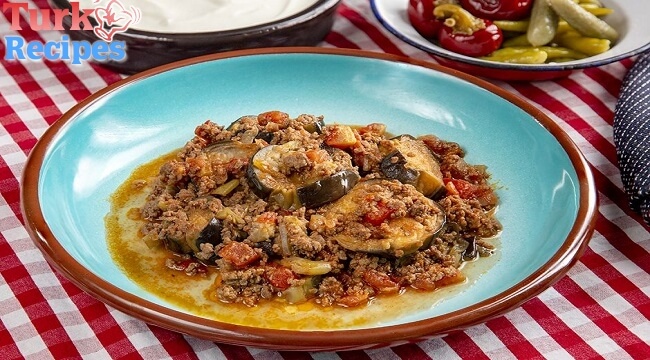
Ravioli
-
1,5 cups of flour
-
1/4 cup water
-
1 egg
For mortar:
-
200 grams of ground beef
-
1 nectarine
-
1 teaspoon of salt
-
1/2 teaspoon black pepper
To boil the mantı:
-
4 cups of broth
For the sauce:
-
2 spoonful butter
-
1 teaspoon pepper paste
-
1 teaspoon of mint
-
1 cup broth (you can use the boiled water of the manti)
For the above:
-
1 cup yoghurt
How to Make Mantı Recipe?
-
To prepare the Mantı dough; flour in an oval mixing bowl. Open the central part. Add the egg. Add the water into the flour and add the water gradually. Stir until all ingredients are recovered.
-
Take the collected dough on the kitchen counter. Continue to knead to suppress.
-
Mix the minced meat, salt, pepper and grated onion in a bowl.
-
Spread the dough in a round shape on a floured kitchen counter using a roller.
-
Cut the dough lengthwise two fingers thick. Then cut the transverse to obtain small squares. Do the same on the other dough.
-
Place the small pieces of mantı in the middle part of the prepared mortar with minced meat. Close the ends mutually and combine the dough at the midpoint.
-
Boil the broth in a deep saucepan. Boil the prepared ravioli in boiling water for about 8- 10 minutes. Strain the boiled mantı with a colander and take to the serving plate.
-
For sauce; melt the butter in a small saucepan. Add the pepper paste and fry for 2-3 minutes. Add the mint and mix. Add the mantı from the boiled broth and open the consistency of the sauce.
-
Serve as lukewarm, add the whipped yogurt and the sauce you prepared on the mantı. Share proudly with your loved ones.
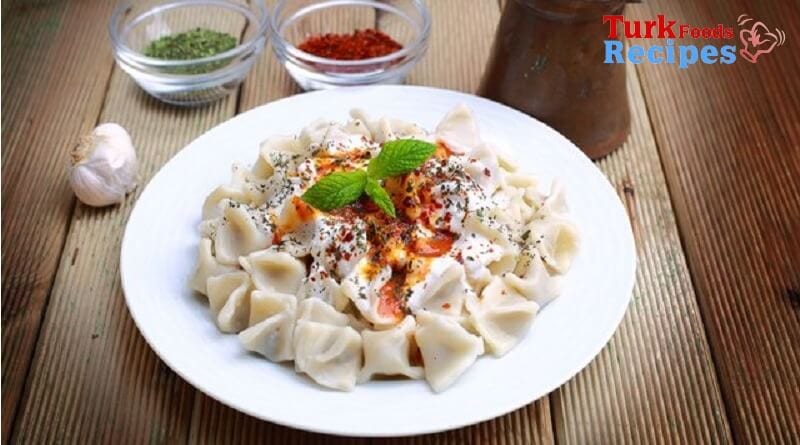
Adana Kebab
-
700 grams of ground beef
-
300 grams of lamb minced meat
-
1 clove of garlic
-
2 pieces of onions
-
1 teaspoon of chili peppers
-
1 teaspoon black pepper
-
1 teaspoon hot pepper paste
-
7-8 sprigs of parsley
-
1 chopped red pepper
How to make Adana Kebab ?
Chop the onions and garlic very thin.
Mix the lamb and beef with onions and garlic and knead well.
Then add spices, tomato paste, red pepper and parsley to knead.
Then leave the kebab in the refrigerator for 2-3 hours.
Lubricate the baking wire with tail oil or butter if not present.
Place the ground beef on the skewers.
I put some of the skewers on the tray and some of them on the grill wire and put koroplast baking paper into the oven. If you want your Adana kebabs to be more juicy and soft, you can cook them on the tray or grill.
Place the skewers on the wire shelf and cook for 20 minutes.
Adana Kebab Ready !
Enjoy your meal…
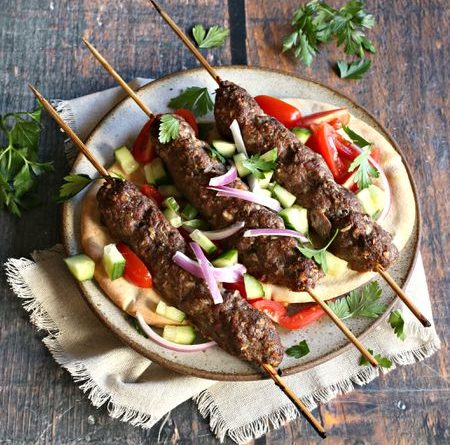
Ayşenur GÖKÇE SEYFİK/Olukman Secondary School
Homemade Turkish Lahmacun
Ingredients
For the Dough:
-
2 cups (240 grams) all-purpose flour
-
1 teaspoon instant dry yeast
-
1 1/2 teaspoons kosher salt
-
1 cup warm water
-
1 tablespoon olive oil
For the Topping:
-
3/4 pound ground beef, 70 percent lean
-
1 medium yellow onion, finely grated
-
3 to 4 cloves garlic, finely grated
-
1 cup finely chopped Italian parsley leaves
-
2 medium ripe tomatoes, finely grated
-
1/2 medium green bell pepper, finely grated
-
1 tablespoon red pepper paste
-
1 tablespoon tomato paste
-
1 teaspoon paprika
-
1 teaspoon red pepper flakes
-
1 teaspoon ground cumin
-
1 teaspoon kosher salt
-
1/2 teaspoon freshly ground black pepper
-
Lemon wedges, for garnish
Add the flour to a large mixing bowl followed by the yeast and salt and combine. In a small bowl, stir the warm water together with the olive oil. Make a well in the middle of the flour with a spoon and pour the water and oil mixture into it. Blend the flour into the liquid by folding the dry ingredients from the sides into the center. Flour your work surface and your hands. Turn out the dough and knead it for about 15 minutes until the dough is soft and elastic. Drizzle a little bit of olive oil inside the mixing bowl and spread it around with your fingers to oil the inside. Put the dough back in the oiled bowl and cover it with a cloth or towel. Leave it in a warm place to rise for 30 to 45 minutes. The dough should rise to about double the size. While the dough rises, prepare the topping. Gather the topping ingredients. Mix all the ingredients together in a large bowl. Set aside.
Preheat the oven to 450 F. Put a large a nonstick sheet tray into the oven to preheat. Turn out the dough on a floured surface and divide it into 6 even pieces. Roll out each piece into a very thin round or oval shape. Try to get each one as thin as possible without tearing it. Spread the topping thinly and evenly over the top of each dough round with your fingers. Don’t press down too hard.
Remove the sheet tray from the oven (with oven mitts) and carefully place each lahmacun on it. Don’t allow them to overlap. Bake for 7 to 10 minutes, until the topping is sizzling, and the edges of the dough are brown. Always check the lahmacuns as they cook to prevent them from burning. Serve the lahmacuns piping hot with lemon wedges for squeezing and a plate of sliced onions mixed with sumac and sprigs of Italian parsley.
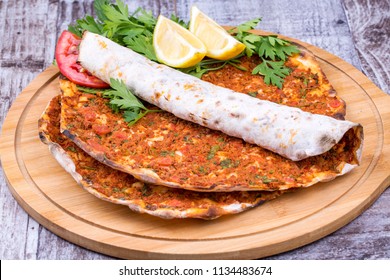
Turkish Navy Bean Salad (Piyaz)
Ingredients
-
1 cup beans (navy, dry)
-
1 onion (red)
-
2 ripe tomatoes
-
1 pepper (green pepper of your choice)
-
1/3 cup parsley
-
1 egg (hard-boiled)
-
1/4 cup olive oil (extra virgin)
-
4 tbsp. apple cider vinegar (or grape vinegar)
-
1 tablespoon lemon juice
-
Salt (to taste)
-
Black pepper (to taste)
-
Garnish: 6 black olives
-
Garnish: 4 lemon wedges
-
Garnish: hot pepper flakes
-
Garnish: sprigs of Italian parsley
-
The night before, put the dry beans in a large bowl and cover them generously with water. Let them soak overnight. The next morning, drain the beans and put them in a pot with fresh water. Let them boil softly until tender. Allow them to cool in the water, then drain them well.
-
If you want to save time, substitute the dry beans with canned Navy beans. Drain them and rinse them under cold water before you use them.
-
Put the drained beans in a large bowl. Drizzle the vinegar over the top. Cover the bowl with a lid or plastic wrap and let it rest for about one hour.
-
In the meantime, chop the tomatoes into small cubes, cut the pepper into rings and chop the parsley. Peel the onion, cut it in half, and cut it into half-circle slices. Wearing rubber gloves, rub the onion slices between your hands or on a wooden cutting board to soften them.
-
Drain the extra vinegar from the beans. Toss the chopped vegetables and parsley in with your fingers. Put the beans on a large, flat serving plate or distribute them on individual salad plates. Spread the onion slices evenly over the top.
-
For the dressing: mix the lemon juice, olive oil, and salt and pepper together then drizzle it over the salad.
-
Garnish the top with black olives, slivers of hard-boiled egg, lemon wedges and parsley sprigs. Sprinkle with hot pepper flakes, if desired.
-
Serve and enjoy!
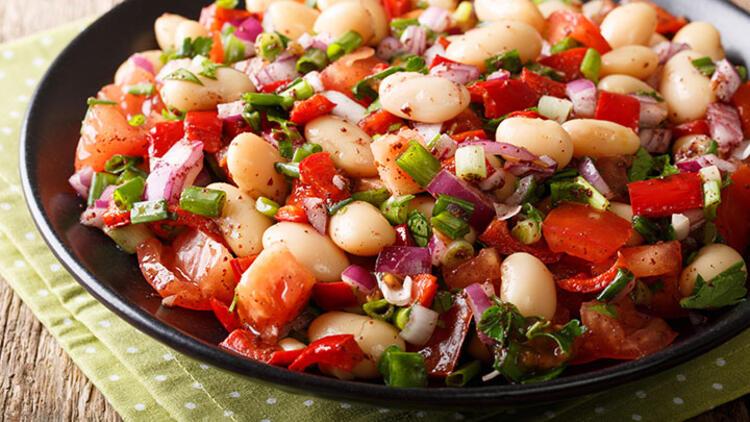
Fırın Sütlaç (Turkish Baked Rice Pudding)
Ingredients
-
2cups uncooked white rice
-
1 to 2cups water, or enough to cover rice
-
4 3/4 cups plus 3tablespoons whole milk, divided
-
1cup granulated sugar
-
1teaspoon pure vanilla extract
-
2tablespoons cornstarch
-
1 large egg yolk
Gather the ingredients. Heat the oven to 350 F / 180 C.In a colander, rinse the rice until the water runs clear.In a large saucepan, add the rice and enough water to cover it by about 1/2 inch.Bring to a boil, then reduce the heat. Let the rice simmer gently until it’s softened, about 5 minutes.Add 3 3/4 cups of the milk along with the sugar and vanilla extract to the rice. Bring the mixture to a boil. Reduce the heat and let it boil very gently for about 10 minutes.In a small bowl, use a whisk to mix 1 cup of the milk and the cornstarch until smooth.While stirring, gradually pour the milk-cornstarch mixture into the rice.Turn up the heat and continue stirring the pudding until scalding, about 4 to 5 minutes.When the pudding thickens, continue to stir, and cook for about 2 minutes more.Remove from the heat and fill small, ovenproof dessert cups, clay cups, or disposable aluminum pudding cups with the hot mixture.In a small bowl, beat the egg yolk with the remaining 3 tablespoons of milk.Using a spoon, drizzle a small amount of the egg-milk mixture into the center of each dessert cup.With the back of the spoon, use a light, circular motion to swirl the egg yolk from the center to the edges so it spreads evenly over the top of each cup.Bake the pudding cups until the tops are nicely browned, about 20 minutes.
Let the cups cool at room temperature and then refrigerate for several hours before serving. Enjoy it!

Turkish Noah’s Ark Dessert “ Ashura”
You cannot visit Turkey without coming across a very special dessert called Noah’s ark pudding, better known as aşure (aah-shoor-EY’). Noah’s ark pudding is a cornucopia of healthy ingredients such as dried fruits, legumes, and whole-grain wheat that are sweetened with sugar and fruit juices and cooked all together in one pot. This pudding traditionally contains apricots, raisins, currants, figs, pine nuts, walnuts, hazelnuts, chickpeas, and navy beans to name just a few ingredients.
The Oldest Dessert in the World Noah’s ark pudding, like many Turkish dishes, has its own story behind it. Turkish legend has it that the first version of aşure was made by Noah himself. After weeks on the ark, the waters began to recede. As food stocks dwindled, Noah decided to throw bits of everything he had left on the ark into one pot. What he got was a delicious pudding that kept him and his passengers well-fed until the ark finally rested on Mount Ararat in eastern Turkey. Some say aşure is the oldest dessert in the world. In modern Turkish culture, Noah’s ark pudding is a symbol of diversity, friendship, and unity. When cooks prepare aşure, they make a lot, as it’s customary to distribute bowls of pudding to as many friends and neighbors as possible. About Ashura Aşure, the Turkish name for Noah’s pudding, is associated with Ashura. Ashura is common throughout the Middle East and spans many cultures, traditions, and religions. Ashura was originally a Jewish celebration marking the rescue of Moses from the Pharaoh during which Hebrews fasted. Sunni Muslims also connect this period during the year with the deliverance of Moses. For Shia Muslims, the day of Ashura is celebrated a few days before Ramadan, during Muharram, the 10th month, to commemorate the martyrdom of al-Husayn, the son of Ali and Fatima and the grandson of the Prophet Mohammed. Ashura reminds Muslims of the sacrifices the Prophet’s family made for mankind. The Ashura period is marked by the donation and sharing of food and sweets as an act of communion with God and reunition with humanity. We even heard that a version of Ashura is celebrated as far away as Haiti!
Ingredients
• 3 cups uncooked whole grain wheat, or barley
• 1 1/2 cups canned chickpeas, rinsed and drained
• 1 1/2 cups canned navy beans, rinsed and drained
• 1/4 cup uncooked rice
• 3 tablespoons dried currants
• 3 tablespoons pine nuts
• 8 half dried apricots, cut into chunks
• 8 dried figs, cut into chunks
• 3 cups sugar
• 2 cinnamon sticks
• 2 tablespoons orange zest, from 1 orange, optional
• 1 tablespoon lemon zest, from 1 lemon, optional
• 2 tablespoons rose water, optional
Steps to Make It
1. The night before, put the wheat or barley in a large pot and cover it with plenty of water.
2. Bring it to a boil, cover and reduce the heat. Allow it to boil gently for about 10 minutes.
3. Turn off the heat and leave the grain to cool and soak overnight.
4. The next morning, the grain should have absorbed most, if not all the liquid. Gather the rest of the ingredients.
5. Add the chickpeas, beans, rice, dried fruits, sugar, and optional rose water or orange and lemon zest.
6. Add more water to just cover the ingredients if needed. Bring the mixture to a boil.
7. Stir the mixture gently with a wooden spoon as it cooks until it thickens.
8. Remove it from the heat and fill dessert bowls or a large serving bowl with the pudding.
9. Once it cools down and sets, cover, and refrigerate it for several hours.Before serving, garnish the pudding with fresh pomegranate seeds, pine nuts, finely chopped dried fruits, and groundnuts.
Bon Apetit..
From İlknur Altınkum,Düzce Yavuz Selim Vocational and Technical High School
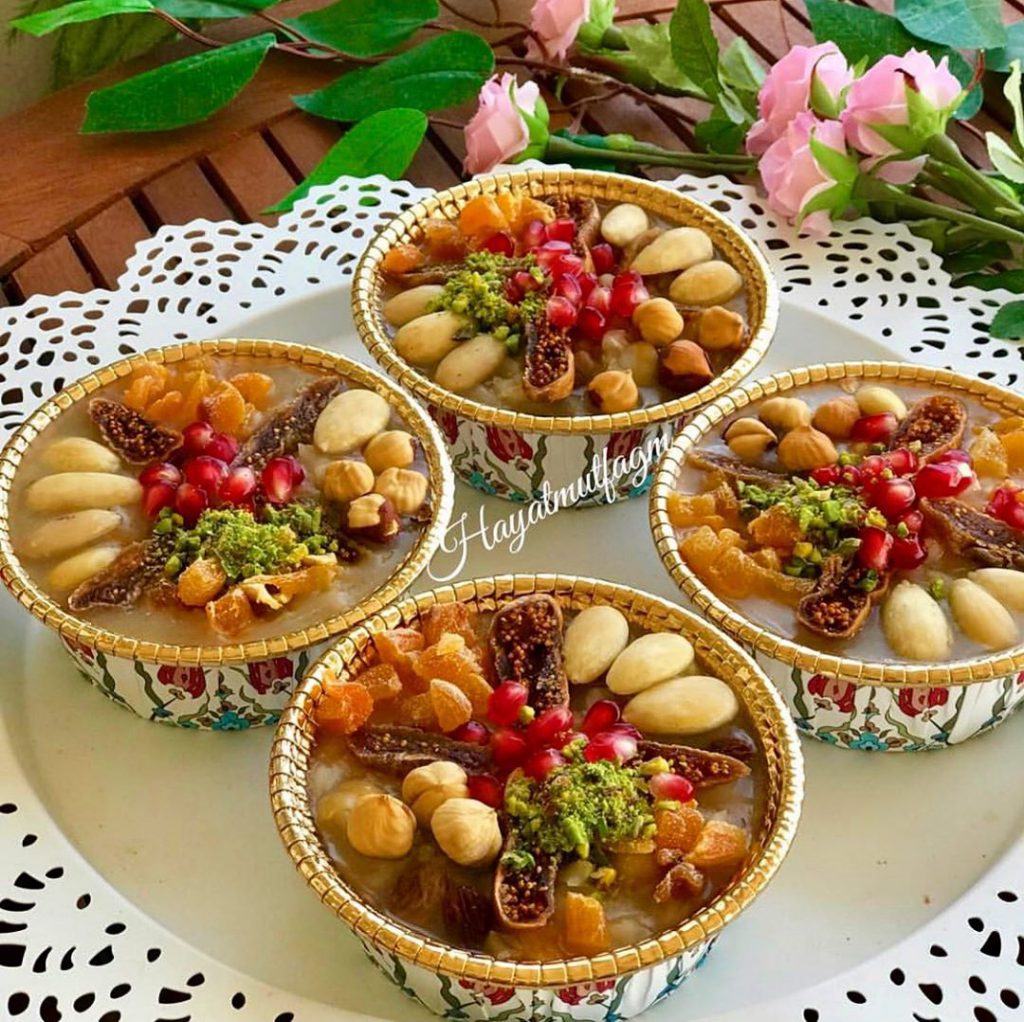
ÖzlemAKSOY- Dr. Nurettin Beyhan Elbir Secondary School
Testi kebab ; a meat and vegetable dish that needs to be broken open before it’s eaten.

Çiğ Köfte; a raw meatball dish in which the meat is usually substituted with bulgur and/or ground walnuts.
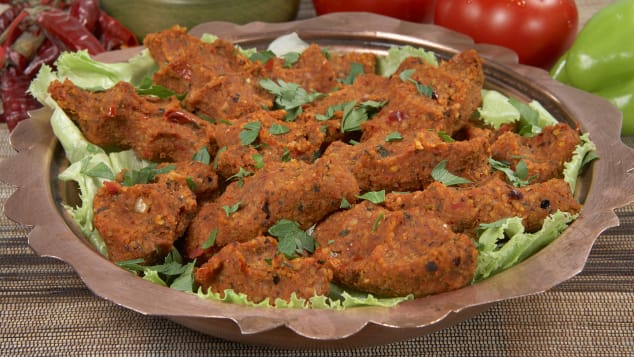
Pide;A type of flatbread made from stretched out dough balls stretched and inserted with a range of fillings.
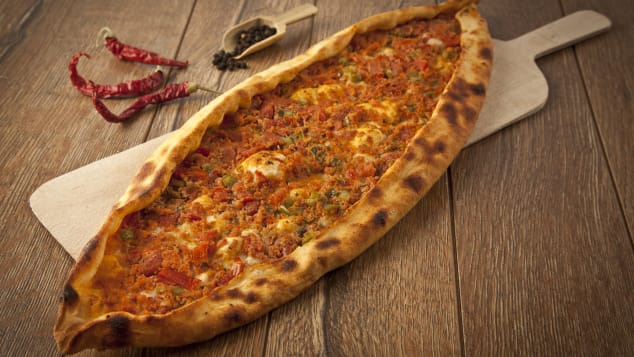
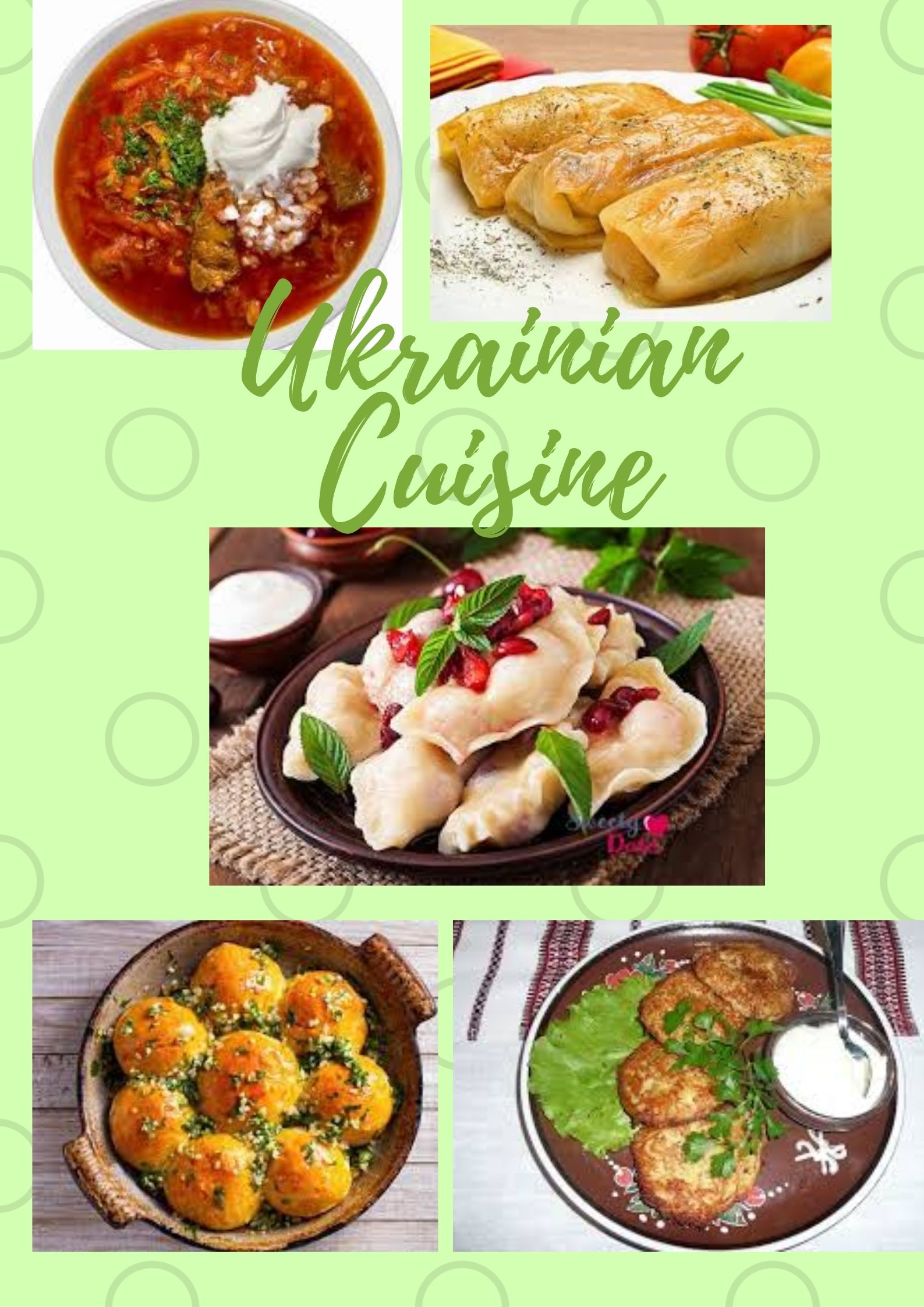
Svitlana Fedirko, Pyriatyn Lyceum №6, Ukraine
Ingredients for Borsch
-
Beets Cabbage
-
Potatoes Carrots
-
Onion Garlic
-
Dill Tomato paste
-
Vinegar and sugar Bay leaves
-
Water or broth Salt and pepper
How to Make Borsch
It is actually very easy and anyone can do it. I like my borsch full of vegetables, with thin broth, lots of fresh garlic and dill.
- Prep veggies: You want to start with cabbage first because it takes longest to cook. While cabbage is cooking, you can prep other veggies.
- Cook cabbage in broth with bay leaves and peppercorns for 20 minutes after bringing to a boil. Chop beets, potatoes, carrots and onion in the meanwhile.
- Saute onion and carrots in a bit of olive oil until translucent, about 5 minutes. This makes onion flavorful.
- Then add beets and a bit more oil, cook for another 5 minutes.
- Transfer sauteed veggies to the pot along with potatoes, tomato paste and salt. Cook covered for 20 minutes. In the meantime, prep garlic, dill and other seasonings.
- Season borscht with vinegar, garlic, sugar and pepper. Stir, turn off heat and let borscht stand for 10 minutes covered to allow flavors to “marry” each other. Add dill and serve.
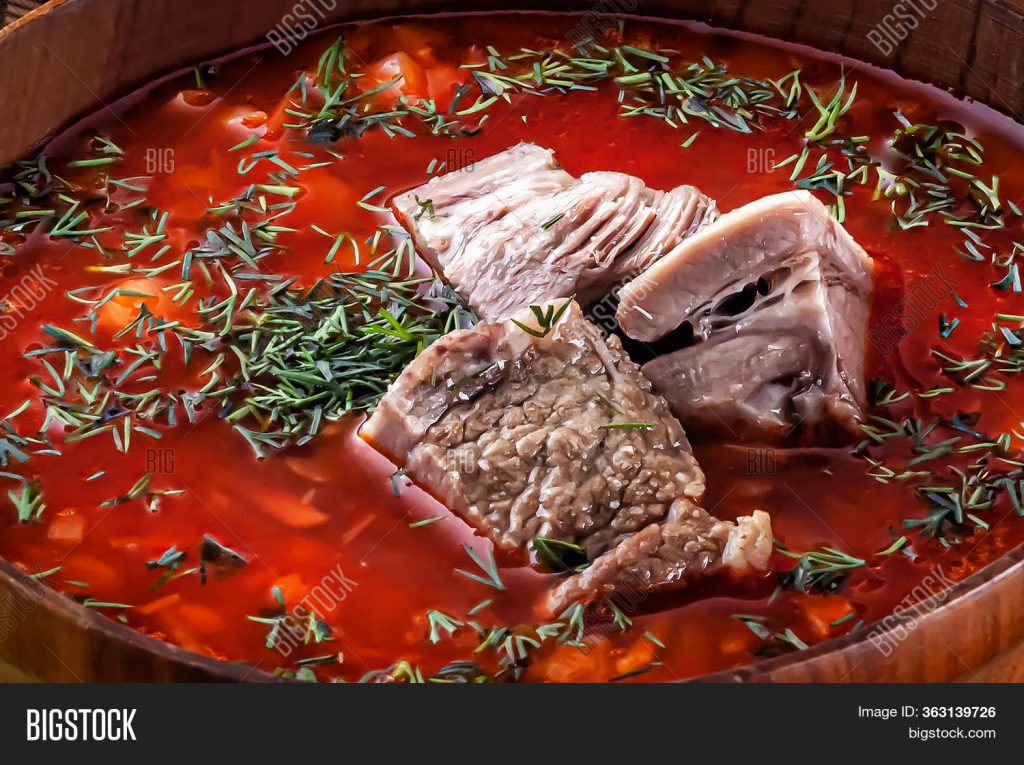
Varenyky
Ingredients:
For dough:
- 1 glass of kefir
- 5 glasses of wheat flour
- 0.5 tsp. of baking soda
- 1 pinch of salt
For the filling:
- 8 potatoes
- 2 onions
- 3 tbsp. sunflower oil
- 10 g butter
- 1 pinch of salt
- 0.5 tsp. black ground pepper
Directions:
- Wash and peel the potatoes, wash once again. Cut in large pieces. Put the potatoes in a saucepan and pour it with cold water, add salt and put on medium heat. Bring the water to a boil, then reduce the heat and cook until ready for about 25 minutes.
- Peel the onion and cut in cubes. Preheat the frying pan with vegetable oil and fry the onion on medium heat until golden for about 5 minutes, occasionally stirring with a spatula.
- Drain the water from boiled potatoes. Add butter, a third part of the fried onions and blend the potatoes. Add salt, pepper to taste and mix thoroughly with a spoon. Put the filling in a plate and leave to cool off.
- Pour kefir and soda into a separate bowl, add salt and mix thoroughly. Then add the flour by half a glass each time, carefully mixing with a spoon. Spread the dough on the processing board for kneading and knead until homogeneous. It shouldn’t stick to hands.
- Cut off a 2cm dough strip and cut it into cubes on the processing board. Mash the cubes in flour on both sides and roll out with a rolling pin.
- Put the potato filling in the middle of the circle of dough and pinch the edges. Put dumplings on a processing board sprinkled with flour, so that they do not stick to the surface. The dough is enough for about 25 varenyky. You can freeze dumplings in a freezer and cook them later.
- Pour cold water in a saucepan, salt to taste and boil on high heat. Put the dumplings in boiling water, moving them with a spatula so that they do not stick to the bottom of the pan. Leave to cook on medium heat. Remove the heat in 2-3 minutes after the dumplings pop up on the surface. Dry the water, put varenyky in a bowl. Mix with the rest of the fried onion. Serve hot with sour cream.
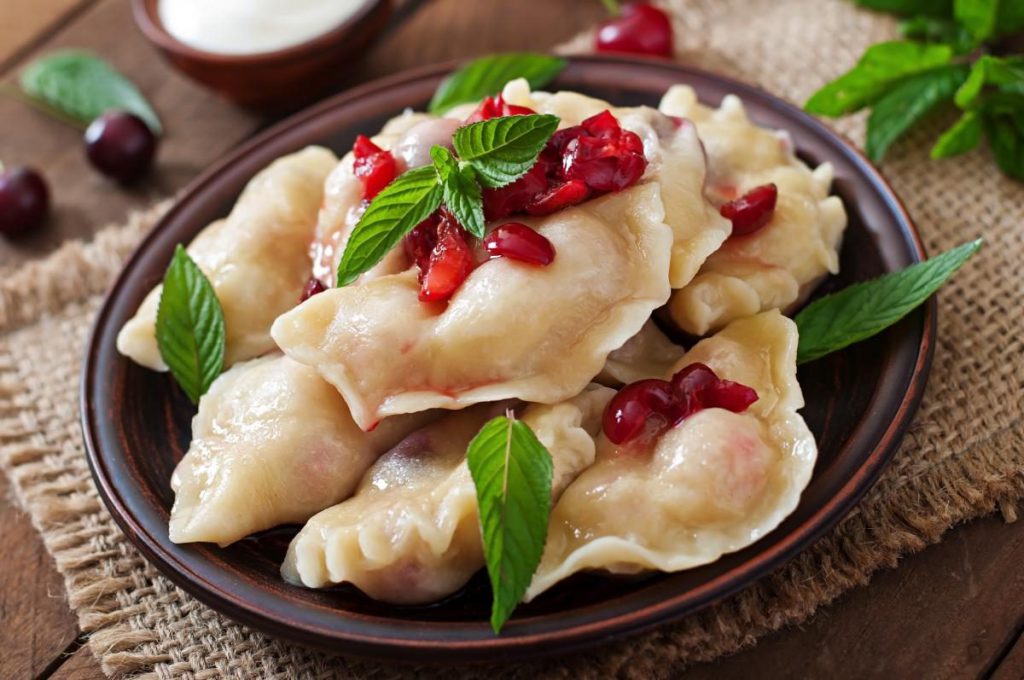
Holubtsi
You’ll need:
~ Cabbage ~ ~ 400 grams of rice~
~ 500 grams of minced meat ~
~ tomato paste ~ ~ 1 onion ~
~ 1 carrot ~ ~ 1 egg ~
~ spices ~ ~ salt ~
What to do:
1. Boil rice
2. Mix egg, minced meat, salt and spices
3. Fry onion, carrot, tomato psate and salt
4. Boil cabbage
5. Put minced meat in cabbsge leaves
6. Boil what e got
7. Put fried carrot, onion and tomato paste on it.
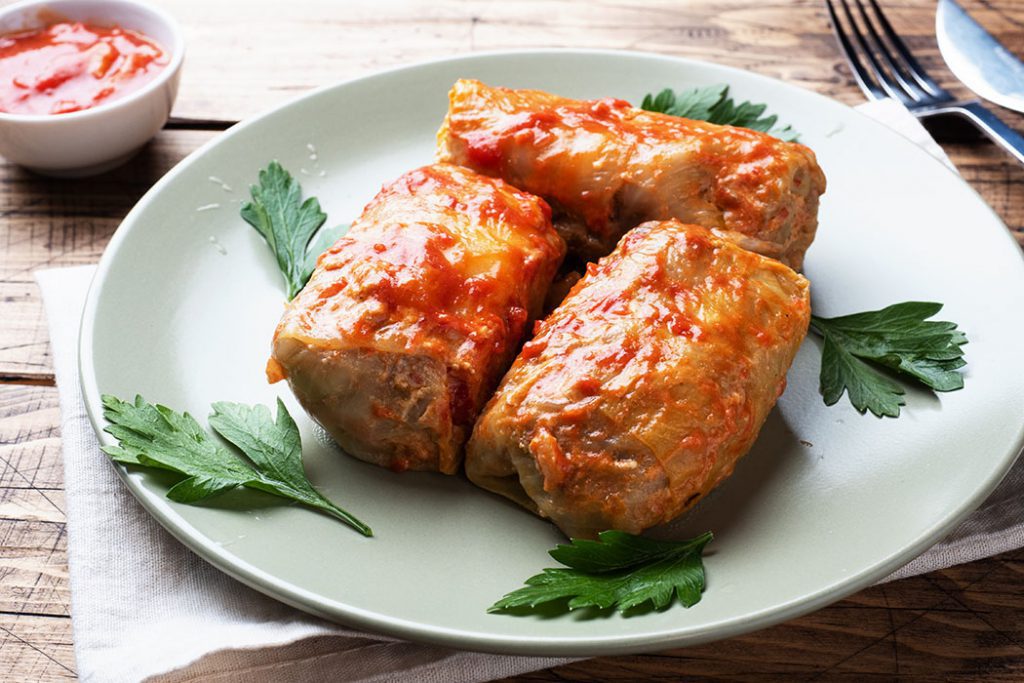
Ş.P.Ü. ERDEM MUT SECONDARY SCHOOL /DEMET KONUKSEVER/AMINENUR
- First, add the milk and sugar to the pot and cook until the sugar dissolves.
- After the sugar melts, wait for it to come to room temperature.
- Then , Lay the Gullac leaf on tray and pour 1-2 ladle of milk on it
- After then, Do the same with 5 Gullac leaves. Sprinkle walnuts on the 5th floor. Use walnut leaves 5 time.
- Finally, refrigerate for 2-3 hours.
You sour use cherry and peanut powder while serving.
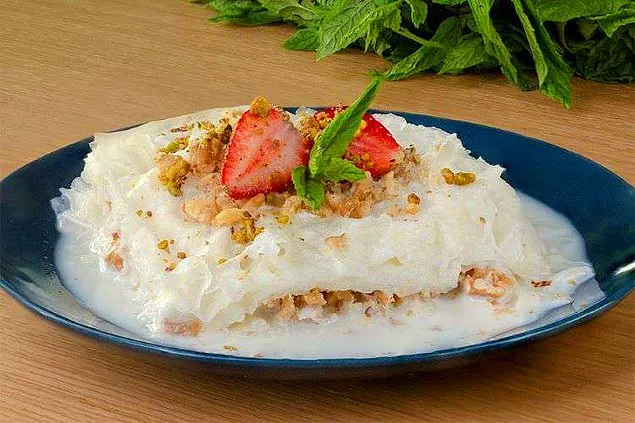
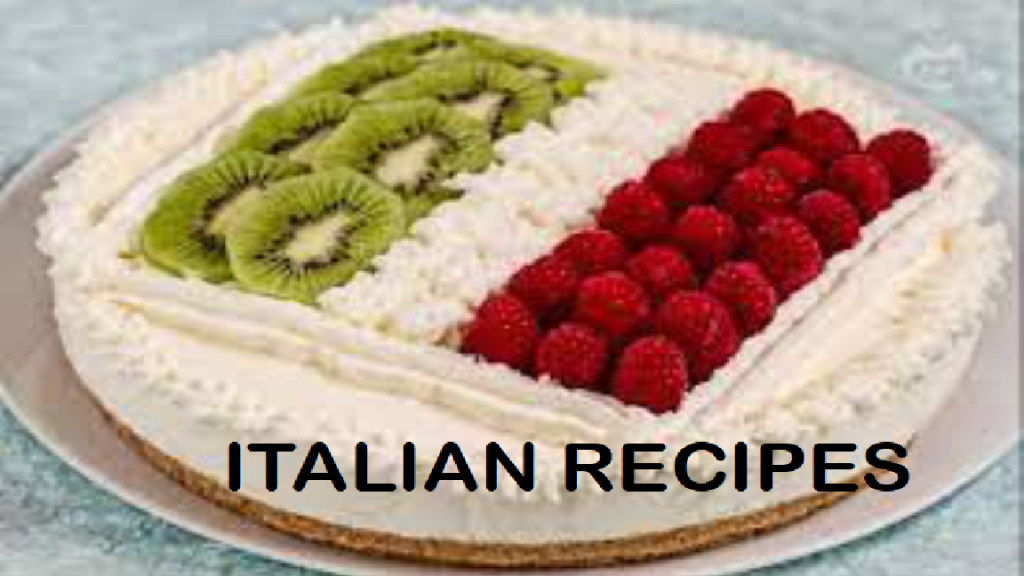

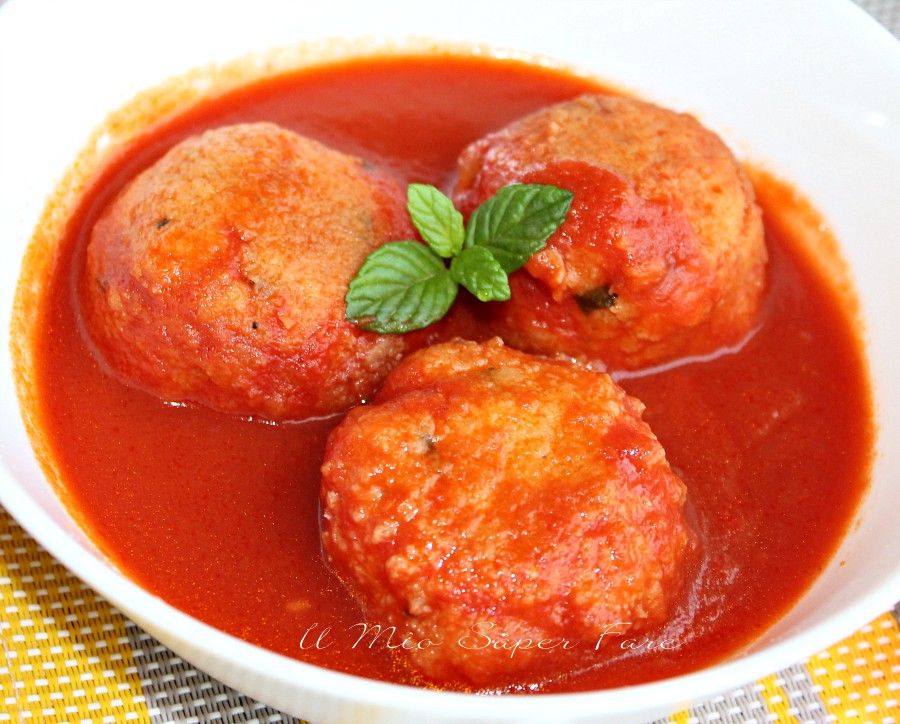
“Pallotte cacio e ova”
“Pallotte cacio e ova”is a dish of the poor cuisine of Abruzzo,made with the few ingredients that were available to all the families of farmers and shepherds of this wonderful regionin the past: eggs, stale bread and pecorino cheese. The tomato sauce completes and refines the taste. The “pallotte”,despite their rusticity, are very delicate and can represent a perfect appetizer on holidays (during Easter,for example) or a light but very tasty second course.
Ingredients:
- Eggs
- Stale bread
- Pecorino cheese
- Parsley
- Garlic
- Milk or water
- Seed oil
- Tomato sauce
Preparation
Soak the breadcrumbs in milk for 15 minutes.
Then squeeze them well and crumble them into a bowl. Add the eggs, pecorino cheese, chopped parsley,garlic into small pieces and pepper.
Mix everything until you get a homogeneous and fairly compact mixture. If it is too soft, add the other crumb. Cover the mixture and let it rest in the fridge for at least 1 hour. Remove the dough from the fridge and form meatballs with your hands.
In a large pan with high sides, place plenty of seed oil and as soon as it is hot, start frying the “pallotte” a few at a time.
As they are ready and have taken on a golden color, drain them on absorbent paper, once fried and keep them aside.
Meanwhile,prepare the tomato sauce. Pour a drizzle of oil into a pan and gently fry the finely chopped onion.
Add the tomato,half a glass of water,add salt and cook over low heat for 20 minutes. Add the fried pallotte and leave them to flavor for 10 minutes, stirring occasionally.
Serve the “cacio e ova pallotte” decorating the dish with parsley or fresh basil.
This is the original recipe but over time it has changed,for example someone doesn’t put the breadcrumbs inside,someone puts them in the oven instead of frying them,but there are many other ways to cook them.
PIZZA!! (by Chiarini School)
A short history – Even if the pizza is considered originating in the Italian culinary tradition, and above all Neapolitan, in the world also Egyptians, Greeks and Romans cooked a very similar flat focaccia! Therefore Pizza has a long, complex and uncertain history, however the first attestations of the word date back to 997 near Gaeta. If there is a name to which the invention of pizza can be associated, it is certainly that of Raffaele Esposito, owner of the historic Neapolitan tavern. In 1889, he dedicated a pizza to Queen Margherita of Savoy, from which it took its name. It was a simple preparation that wanted to represent the new Italian flag: basil for the green, mozzarella for the white and tomato for the red. The pizza phenomenon, despite its great success, remained confined to the Kingdom of Naples.
Ingredients:
-
300 g Manitoba flour
-
200 g flour 00
-
300 ml of water
-
1 tablespoon extra virgin olive oil
-
1 tsp salt
-
1.5 dry beer yeast
For preparation:
-
400 ml tomato sauce
-
400 g Nodes of Delicious Mozzarella
-
basil
-
extra virgin olive oil
-
salt
Put in a bowl the two types of flour, the beer yeast and the water ad mix carefully.
Then pour the olive oil and the salt and knead well.
Cover the bowl and wait for 3 hours. After that pick the pasta and roll it out on a baking tray. Add the tomato souce, the olive oil and salt, the mozzarella cheese in small pieces and the basil.
Put in the pre-heated oven at a high temperature (220 degrees) for about 15-20 minutes.

SAFFRON RISOTTO (by Chiarini School)
Ingredients:
Saffron 1 tea spoon White wine 40 g
Rice Carnaroli 320 g. Water
Butter 125 g Vegetable broth 1 L
Chopped onion 1 Salt
Grana padano cheese 80 g Olive oil
Preparation:
– Put the saffron in a glass, add some water and mix it
– Stew the onion with the oil in a pot
– Add the rice and toast it
– After a minute, add the wine and when it evaporates, add some broth up to cover the rice
– Cook over low heat and add the broth when necessary
– 3 minutes before the end of cooking, add the saffron and mix
– When the rice is ready, turn off the stove, add butter ad cheese and mix it
YOUR RISOTTO iS READY, ENJOY IT!
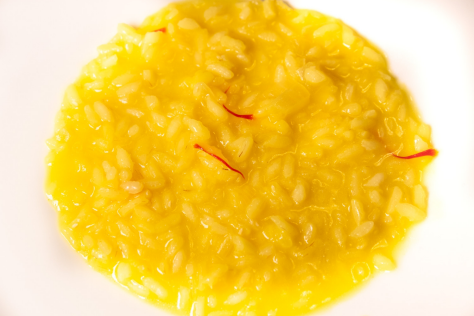
SPAGHETTI OR PASTA WITH TOMATO SAUCE by Chiarini School
Ingredients
-
Spaghetti 320g
-
Peeled tomatoes 800g
-
Extra virgin olive oil 30g
-
1 clove garlic o 1 chopped onion
-
Basil to taste
-
Salt up to taste
Preparation
-
Start by preparing the sauce: in a pan pour the extra virgin olive oil together with the peeled garlic clove and divided into half, so you can eliminate the soul to make the scent more delicate. After minutes of cooking over high heat, add the peeled and chopped tomatoes.
-
Turn on the very low heat and add the basil leaves.
-
Cover with a lid and cook for at least 1 hour over very low heat: the sauce must simmer gently
-
Stir occasionally. After the indicated time, remove the garlic so as to obtain a smooth and homogeneous puree
-
At this point you just have to cook the pasta in plenty of boiling and salted water
-
Drain the spaghetti al dente directly into the sauce and mix a few moments over high heat to mix everything
-
Your spaghetti with tomato sauce are ready, you just have to serve and garnish with fresh basil at will

ARROSTICINI
Abruzzo’s recipe by Chiarini School
A short history – This is a typical traditional dish. It has its old origins among the shepherds who prepared it to feed themselves, during the “Transumanza”, looking for better food for sheep, from Abruzzo to Puglia.
Ingredients:
-sheep’s meat
-extra virgin olive oil
-rosemary
-salt
Serve it with toasted bread and olive oil
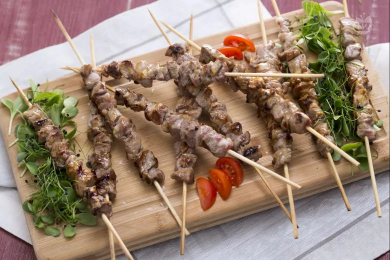
Polenta with sausages and tomato sauce
Abruzzo’s recipe (by Chiarini School)
The history of Polenta
Polenta as we know it, dates back to the age of Columbus, when the European explorer came back from America bringing with him corn, or maize, today widely used for purposes other than nutrition. Before that time, the plant was unknown in Europe. Columbus informed Europeans that the Native Americans made a dish by adding water to cornmeal and serving it with various sauces, cheese and fresh meat. Europeans discovered that the plant was easy to grow, especially in Southern Italy. and it was cheap. This is why it was the main meal to the lowest classes, by farmers and peasants. Polenta is popular throughout Lombardy, Veneto and Friuli, where it is served as a side dish or in place of bread. It can also be served as a main course with thick sauces, sausages, codfish, or fried and sliced, or rolled into gnocchi. Polenta is good if you are on a diet: you can eat it but you must avoid heavy sauces and condiments.
Ingredients for four people:
- 500 grammes of corn flour;
- 2 litres of water;
- 1 spoon of coarse salt;
- 15 grammes of extra virgin olive oil;
- 400 grammes of tomato sauce;
- 300 grammes of pork sausages;
- 80 grammes of parmesan reggiano.
Information about polenta:
- 484 kcal for serving;
- Difficulty: medium;
- Preparation: 20 minutes;
- Cooking polenta: 60 minutes;
- Cooking tomato sauce with sausages: 120 minutes;
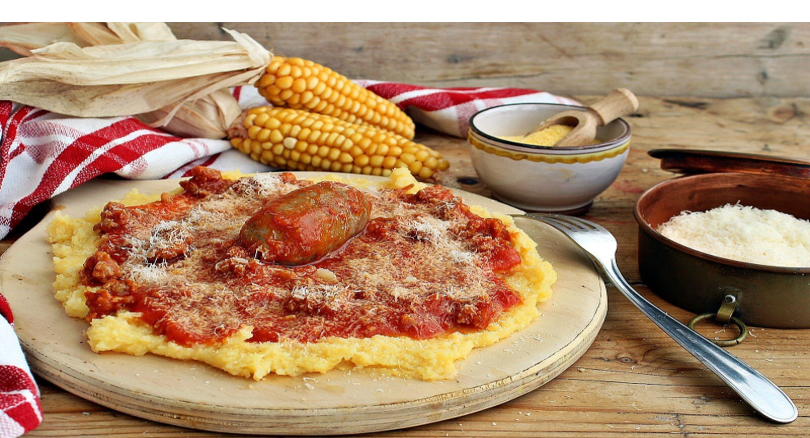
Parrozzo by Chiarini School
It is a typical cake of Abruzzo for Christmas. It’s very delicious.
Ingredients
-
250 g almonds
-
250 g sugar
-
150 g “semolino”
-
6 eggs
-
150 ml “Amaretto di Saronno”
-
1 table spoon oil
-
50 g chocolate
-
2 table spoon milk
Preparation
In a bowl mix yolk with white sugar. Then mix this dough with “semolino”, almonds and “amaretto di Saronno”. Next, whisk in a bowl white eggs with an electric mixer. Then mix these 2 dought. Finally put this batter in a cake pan, in the oven. The cake bakes a 150° for 50/60 minutes.When the cake is ready, we take out and let cold. Next, in a small pot put, chocolate, 1 table spoon oil, 2 table spoon milk and let it melt. Finally put this chocolate frosting on the cake.
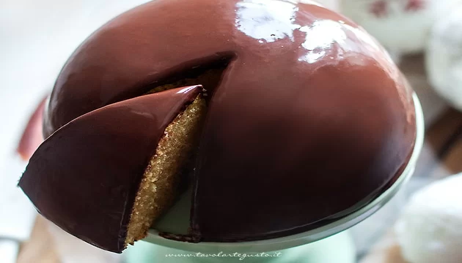
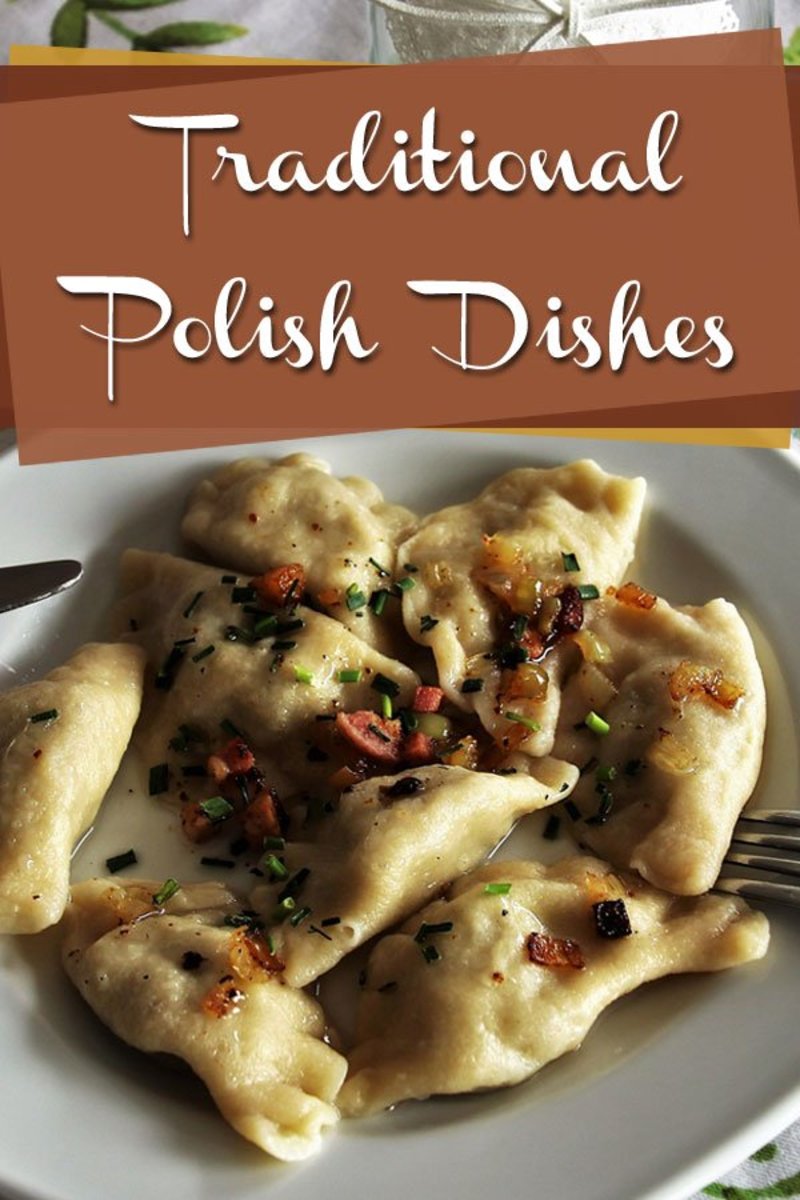
Stewed cabbage (Bigos)
by Blanka (Zespół Szkół w Tulcach)
INGREDIENTS
500 g of pork (e.g. pork neck)
200 g of sausage
1 onion
2 tablespoons of vegetable oil
3 cups of broth or water
30 g of dried porcini mushrooms
2 tablespoons of plum jam or a few prunes
1 apple (e.g. rennet or Antonovka) – optional
1 kg of sauerkraut
PREPARATION
Dice the meat. Dice the onion and sauté in oil in a large pot. Add the meat and sear it thoroughly.
Pour in 2 cups of hot broth or water with salt and pepper, bring to a boil. Then add the broken dried mushrooms, cover, reduce the heat and cook for approx. 45 minutes.
Add bay leaf, allspice, cumin, marjoram, plum jam or chopped plums, peeled and diced peeled apple and mix.
Add squeezed sauerkraut and pour a glass of water, mix. Cover and cook for approx. 15 minutes.
Peel the sausage, dice it and fry it in a pan. Add to the cabbage and cook for about 30 minutes. At the end, add the tomato paste.
Fry the flour in a dry frying pan, when it starts to brown, add a tablespoon of butter and stir until the butter is melted.
Keeping the pan on the fire, gradually add a few tablespoons of cabbage, stirring constantly. Put the contents of the pan back
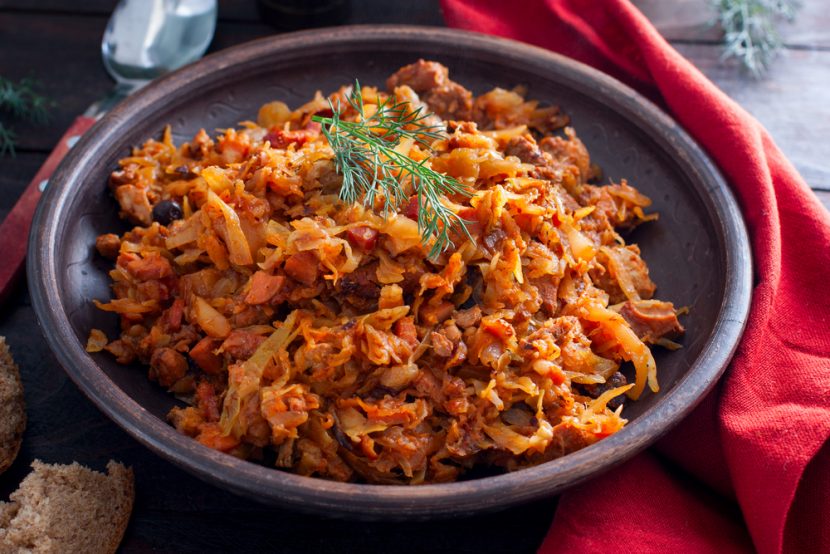
Pierogi
by Lena – Zespół Szkół w Tulcach
Pierogi are filled dumplings of central and eastern European descent made with unleavened dough then filled with either a savory or sweet stuffing before being boiled or pan fried.
Ingredients
- 5 cups flour
- 1 teaspoon salt
- 1 cup water
- 4 tablespoons of oil
- filling may be different:
- potatoes and onions / meat / cheese /cabbage and mushroom
Pierogi
Preparation
How to make Pierogi dough:
In the bowl of a mixer, blend together the flour and salt. Add water and oil.
Continue to blend the flour mixture together until a shaggy dough forms and the dough starts to pull away from the sides of the bowl.
Cover the dough with plastic wrap and allow to rest for 1 hour.
Then prepare small pieces of dough, put the filling you want inside. And finally cook them in boiling water or fry on a frying pan.
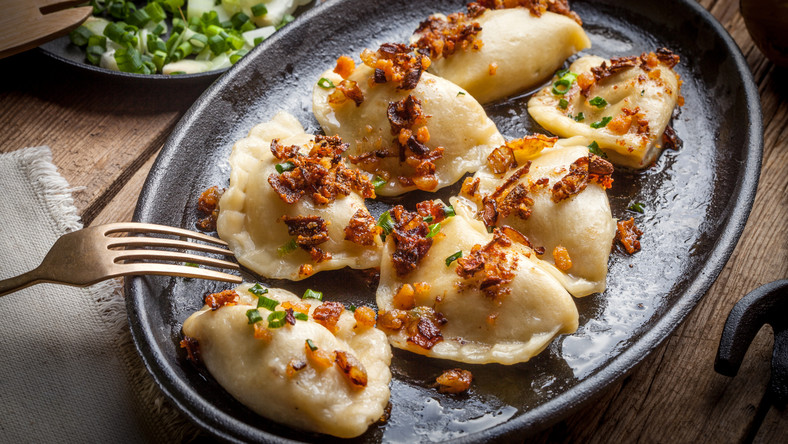
Tomato soup
by Eliza (Zespół Szkół w Tulcach)
Ingredients
broth,
pasta or rice,
tomato paste,
cream,
pepper and salt,
parsley.
Preparation (tomato soup)
Boil rice or pasta.
Heat the broth.
Add the tomato paste and mix it to dissolve. Boil it.
Finally, stir in the cream.
Season to taste with salt and pepper.
Serve with cooked rice or pasta.
Sprinkle with chopped parsley.
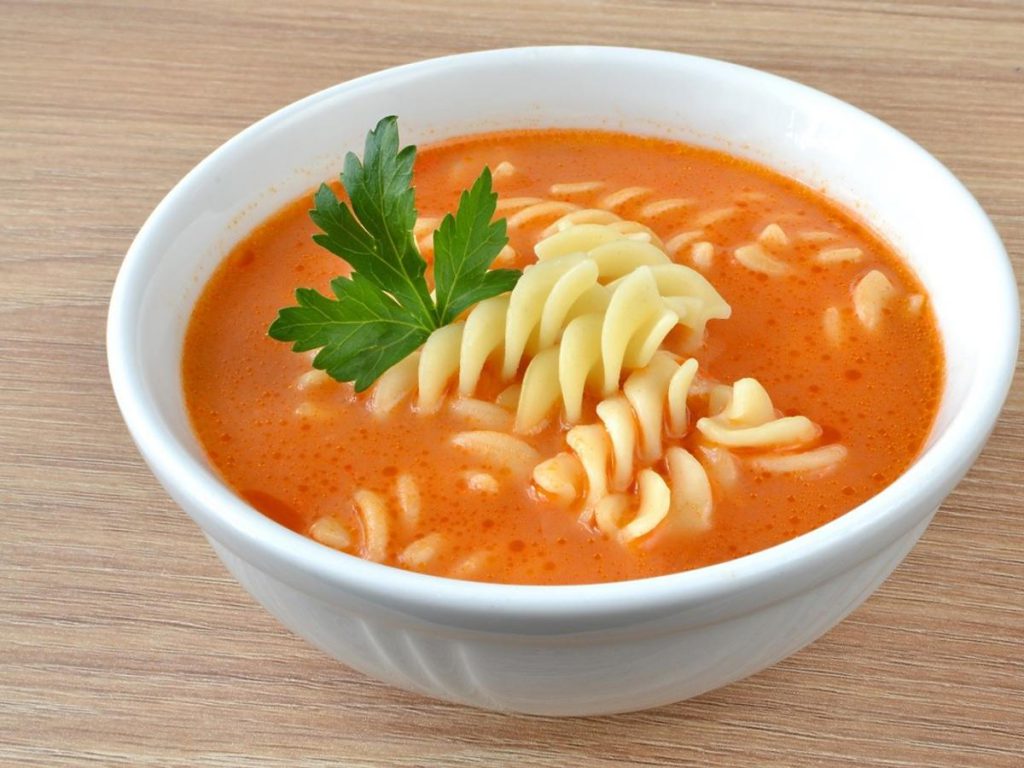
PSP 3 Nisko, Poland
Polish cuisine is a mixture of many types of cooking and has its orygines in neighbouring countries due to Polish dramatic history.
It is reach in meat, especially pork, chicken and variety of sausages. It’s also based on cabbage and cereals and grain products with wide combination of herbs such as garlic, majoram, thyme…
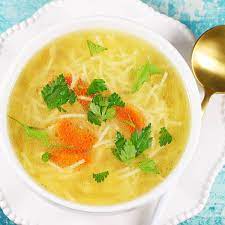
Chicken clear soup- rosół
recipe by Karol and Ewa (PSP 3 Nisko, Poland)
Ingredients:
-
1 whole chicken (about 4 pounds), cut into pieces (including back)
-
8 cups water
-
tablespoon salt
-
3 medium onions
-
2 celery stalks
-
4 garlic cloves, crushed
-
2 medium carrots
-
3-4 bay leaves
-
5 grains of allspice
-
1/2 teaspoon of turmeric
Preparation:
-
Step 1
Bring chicken, water, and 1 tablespoon salt to a boil in a large stockpot. Skim foam. Add onions, celery, and garlic and the rest of herbs. Reduce heat. Simmer, partially covered, for 30 minutes. -
Step 2
Remove breast, and set aside. Add carrots. Simmer, partially covered, for 40 minutes. - Remove remaining chicken; discard back and wings. Let cool slightly. Remove meat from bones, and cut into bite-size pieces.
-
Step 4
Stir in the desired amount of chicken; reserve the rest for another use. Skim fat. Season with salt.
Enjoy your meal
Polish pork chops- kotlet schabowy
recipe by Kuba (PSP 3 Nisko, Poland)
Ingredients:
- 2 boneless pork chops
- salt and freshly ground black pepper to taste
- 1 tablespoon flour
- 1 egg
- 5 tablespoons bread crumbs
- 2 tablespoons vegetable oil,
Preparation:
- Step 1
Place pork chops between 2 sheets of heavy plastic on a wooden board Firmly pound with the smooth side of a meat mallet, until very thin. Add salt and pepper. - Step 2
Pour flour onto a large plate. Whisk egg in a bowl. Place breadcrumbs in a separate shallow bowl. - Step 3
Dredge chops with flour. Dip in whisked egg. Coat with bread crumbs on both sides. - Step 4
Heat oil in a large pan. Add breaded chops; cook until golden brown, about 5 minutes per side.

Meat-stuffed cabbage leaf- gołąbki
recipe by Iza and Gabrysia (PSP 3 Nisko, Poland)
Ingredients:
- 700 g of ground pork
- 100 g of rice
- two onions
- one white cabbage
- 1,5 l of broth
- 600 g tomato puree
- one tablespoon of flour
spices:
- salt and pepper,
- 1 teaspoon dried oregano,
- 1/2 teaspoon paprika powder,
- 1/2 teaspoon thyme
optional:
- 4 tablespoons of cream 18%
Preparation:
Place the meat in a larger bowl. Boil the rice, cool it and add it to the meat. Peel the onion, grate it, add to the meat with rice. Add salt (about half a teaspoon), pepper (1/4 teaspoon). Mix everything and knead it with your hand. Form small oblong chops.
Cut the deep inside of the cabbage, then put it in a large pot of boiling water (cut side down), cook for about 10 minutes over low heat. Turn the cabbage over and cook for about 5 minutes. Remove the cabbage from the boiling water and, after it has cooled down, strip it from the leaves, gently cut off the thickening of each leaf, then put the prepared portions of meat.
Wrap like croquettes (first place the leaf on one side of the meat, then fold the sides inwards, then roll the rest of the leaf as close as possible to the end). Not all of the cabbage needs to be used.
Line the bottom of a large and preferably wide pot with a few cabbage leaves (e.g. those that have torn off). Place the lovebirds on top with the connection side down. Boil the broth in another pot and pour it over the cabbage rolls. Place on the gauze, cover and cook for about 45 – 60 minutes until the cabbage is tender. Do not mix the cabbage rolls during cooking, or shake the pot gently.
Pour the broth from the cabbage rolls into another pot. Add the tomato puree and flour, previously mixed with a few tablespoons of cold water. Bring to a boil, season with salt, pepper, dried oregano, thyme and paprika. Cook for 10 minutes, uncovered.
If you add cream, spread it gradually with the sauce, adding it by a spoonful to the cream while stirring. Pour into a pot with stuffed cabbage and cook the whole for a few minutes over low heat, shake the pot from time to time so that the sauce is evenly distributed.
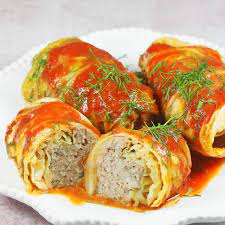
Primary School in Torzym,
Poland
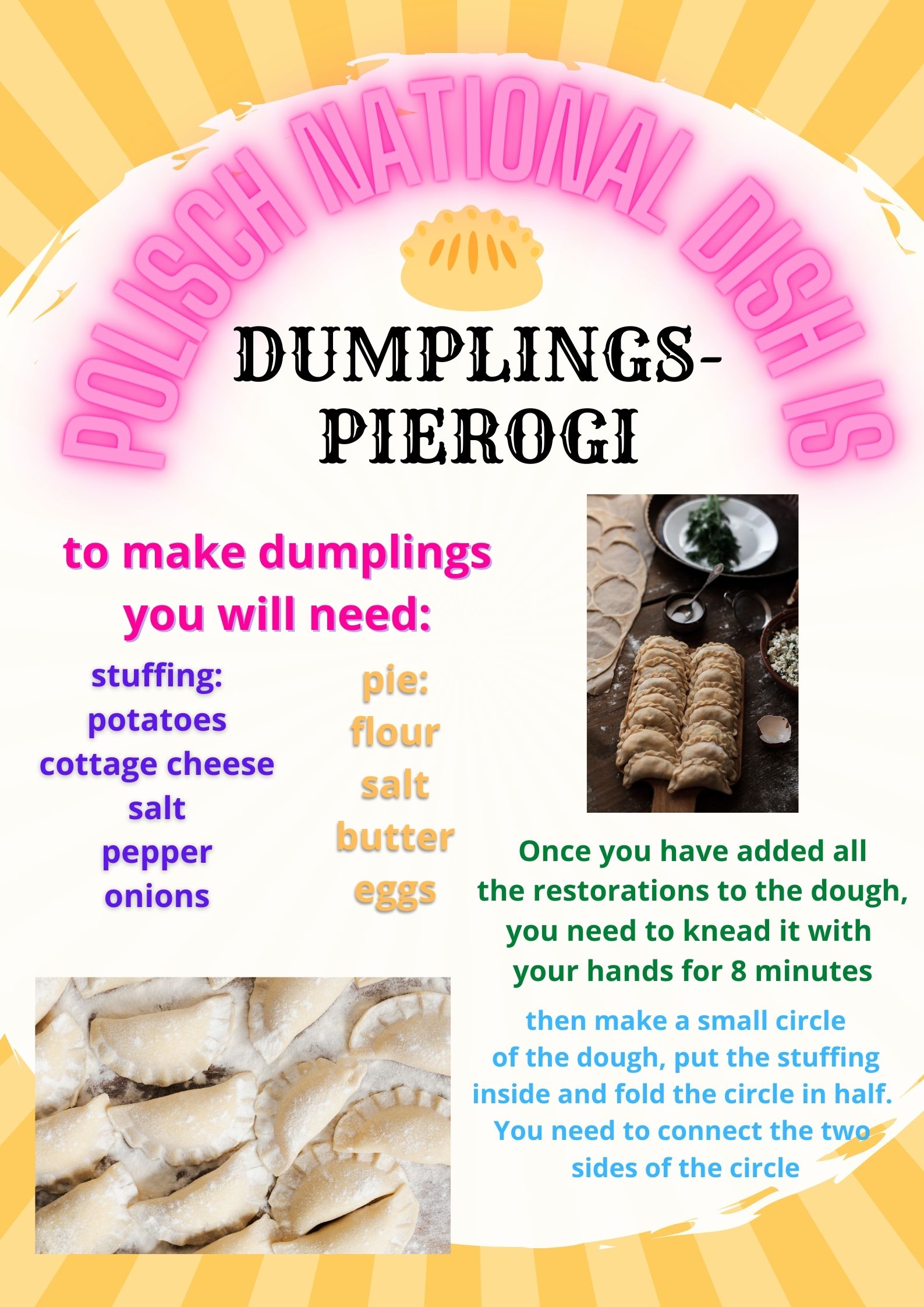
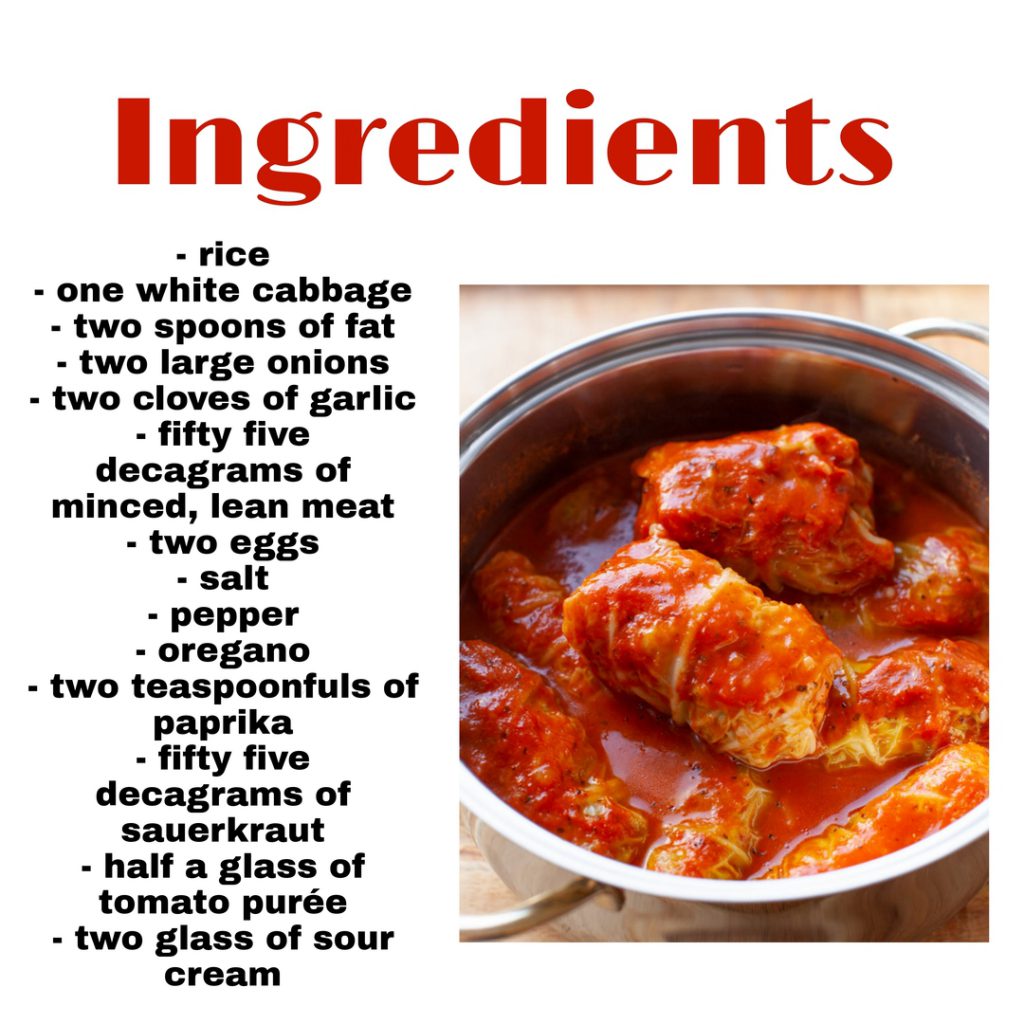
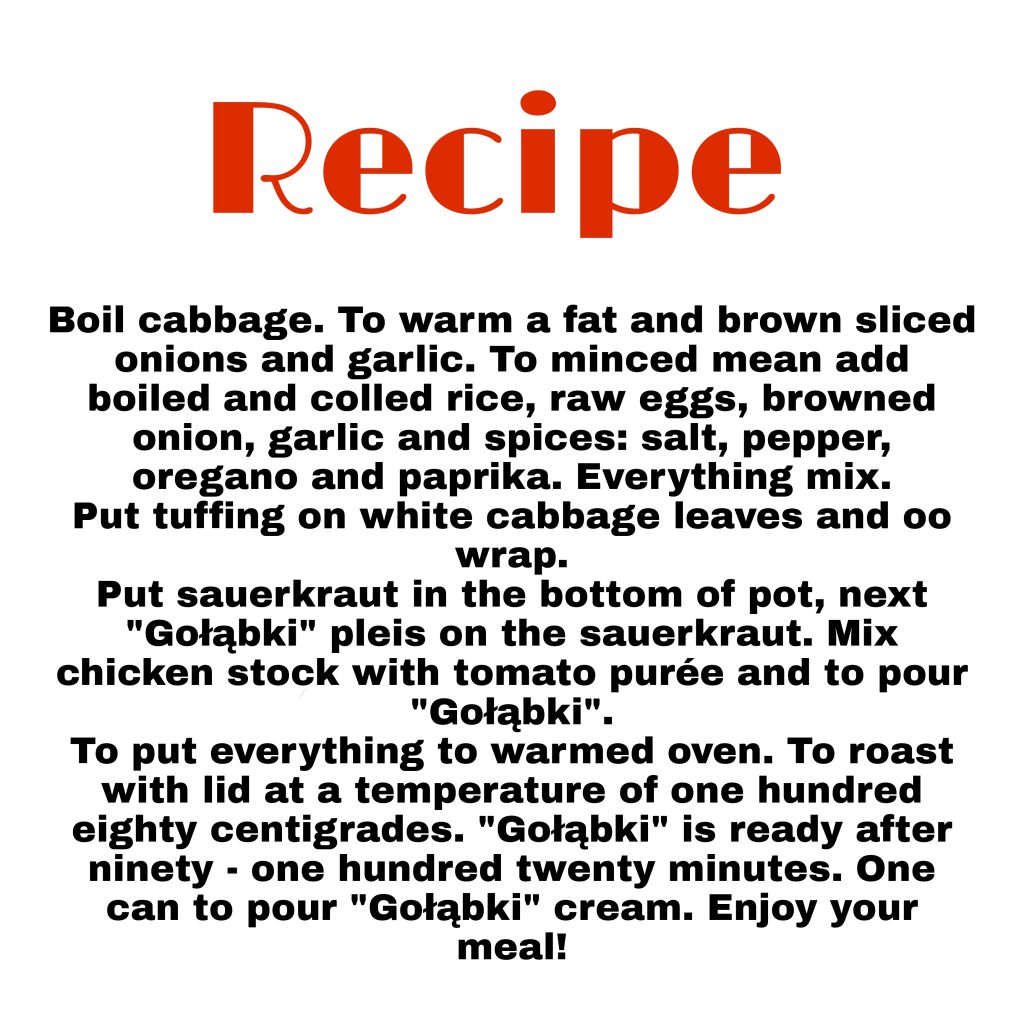
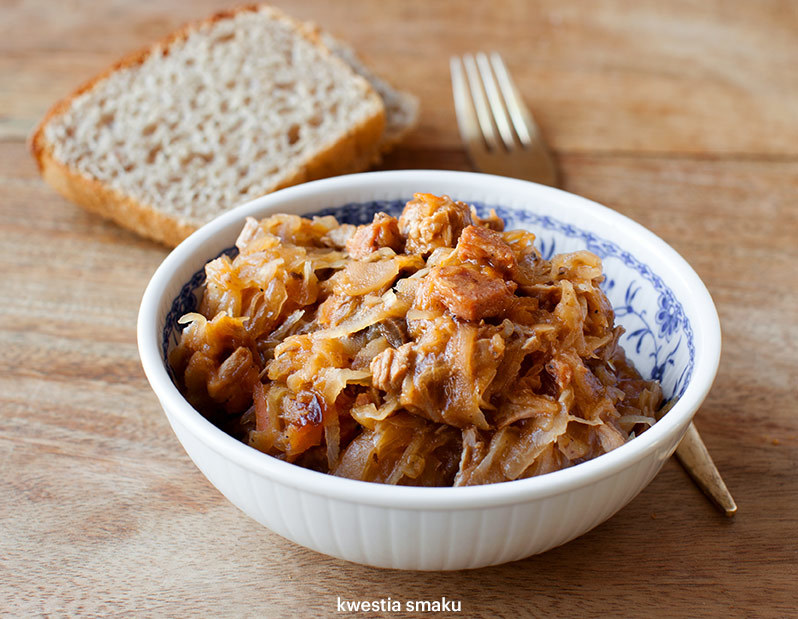
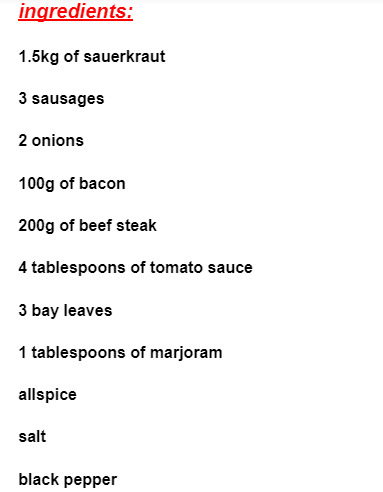
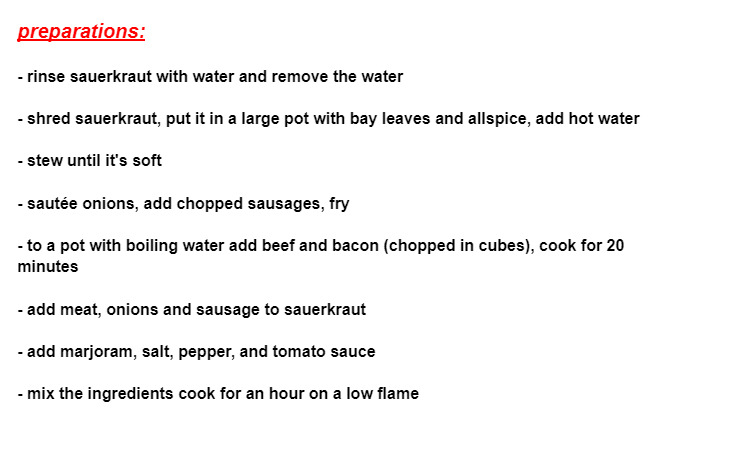
Ş.P.Ü. Erdem Mut Secondary School/Demet Konuksever/Ruken Jinda
Baklava Recipe
one hundred gram butter at room temperature
1/2 tea cup liquid oil
1/2 tea cup milk
1 egg
2 tablespoon vinegar
1/4 tea spoon salt
2 tablespoon yoghurt
One tea cup water
1 water glass flour.
For The Syrup
2,5 water glass granulated sugar
3 water glass water
1/4 lemon juice
For inside:
250 gram powdered pistachios
50 gram antep pistachios
How to make Baklava?
First, the ingredients are mixed in the mixing bowl.
Then add the flour and knead.
Divide the dough and form into meringues
Open the meringues to the size of a dessert plate.
Cover the meringues you have opened and let them rest for 40 minutes.
Sprinkle starch on the meringues, stack a few of them on top of each other and start to roll out the width of your tray.
After applying the same process to all the meringues, separate the phyllo dough from each other and place one of them on a greased tray.
Divide the dough into a bottom layer and an upper layer. Start laying the first layers and brush melted butter between them.
Pour peanuts in the middle.
After removing the other layers and spreading melted butter between them, cut them into squares with a knife.
After adding the remaining butter on it, bake in the oven heated to 195 degrees for 10 minutes. Then lower the oven to 180 degrees and bake for another 35 minutes.
Take it out and pour the hot syrup into the hot baklava. Sprinkle peanuts on top and serve.
Enjoy your meal 🙂
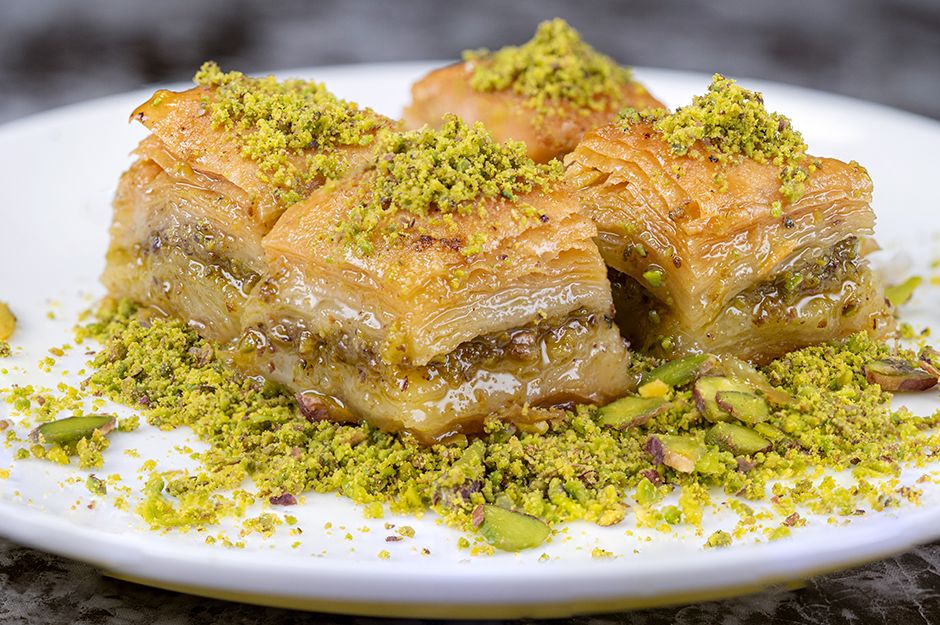
Rioja style potatoes, a traditional recipe.
Ingredients (4-6 servings)
1 and ½ kg of potatoes
1 sausage per person
2 onions
3 garlic cloves
2 teaspoons of chorizo pepper meat
1 bay leaf
Salt
extra virgin olive oil
water
1.Peel the onion and cut into strips, peel the garlic cloves and
fillet them. We put both things in the perola (metal saucepan)
with a little extra virgin olive oil and let them cook over low heat.
2.When they begin to brown, add the sliced, skinless chorizo. We fry.
3.We incorporate the potatoes, which we have peeled, washed and
cut into pieces by clicking them. This is the most important thing,
since in this way the potatoes will release the starch and we will
have a fantastic broth.
4.We also add a little salt, a bay leaf and the chorizo pepper meat.
Mix and cook the potatoes for a couple of minutes.
5. Cover with water and let them cook for about 30 minutes,
until the potatoes are tender.
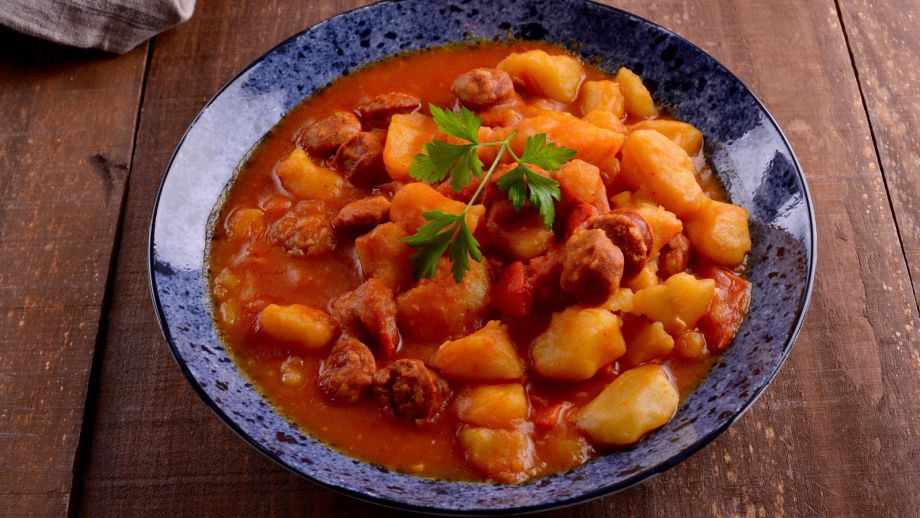
Omelette (tortilla de patata)
Ingredients
8 free range eggs or 10 normal eggs
1kg of gacilian potatoes (or normal potatoes)
Extra virgin olive oil
1 big onion
Salt
Preparation
Peel the potatoes, wash them to remove traces of dirt and very importantly, dry them.
We cut into semi-thin slices, I don’t like them to fall apart but when frying them they brown a little. We place them in a large bowl, where we will later mix with the egg and add salt to taste. We remove well and reserve.
We chose our largest, non-stick pan. We put it on the fire and add a good extra virgin olive oil. Do not be afraid to spend a little money on oil, it will give it that point of flavor that distinguishes your tortilla from the others, you can use many varieties: arbequina, picual, cornicabra, hojiblanca, royal… the one you like the most, but quality.
Add the cut and salted potatoes and let them cook for approximately twenty minutes over low heat. The issue of the thickness of the potatoes also goes to taste. There are those who prefer to cut them into very small pieces, in very thin slices that almost break when frying and or rather large.
While the potatoes are frying, in the bowl where we are going to add the potatoes later, beat the eggs, set aside. Peel the onion and cut as thin as possible.
In another pan, heat olive oil and add the onion pieces. Pochamos until it has a golden color, which has a point of caramelization but without burning. The onion will be done before the potatoes, so drain and add to the bowl with the beaten egg.
Remove with a slotted spoon from the pan, leaving the potatoes with as little oil as possible, well drained. If we do not want any extra oil we can use a large strainer. Let them drain and then add them to the bowl with the onion and the egg.
Rest the future tortilla for 15 minutes so that all the flavors come together well. After those minutes this mixture is already delicious, try toasting some bread and add a layer of this mixture, incredible.
In the same frying pan in which we have fried the potatoes and once the oil has been removed. We cook the mixture that we have at rest. I like it rare, that when you break it with a fork a little liquid egg comes out. For this type of tortilla we only need 4 minutes on medium-high heat on each side. It depends on how curdled we want the tortilla to be.
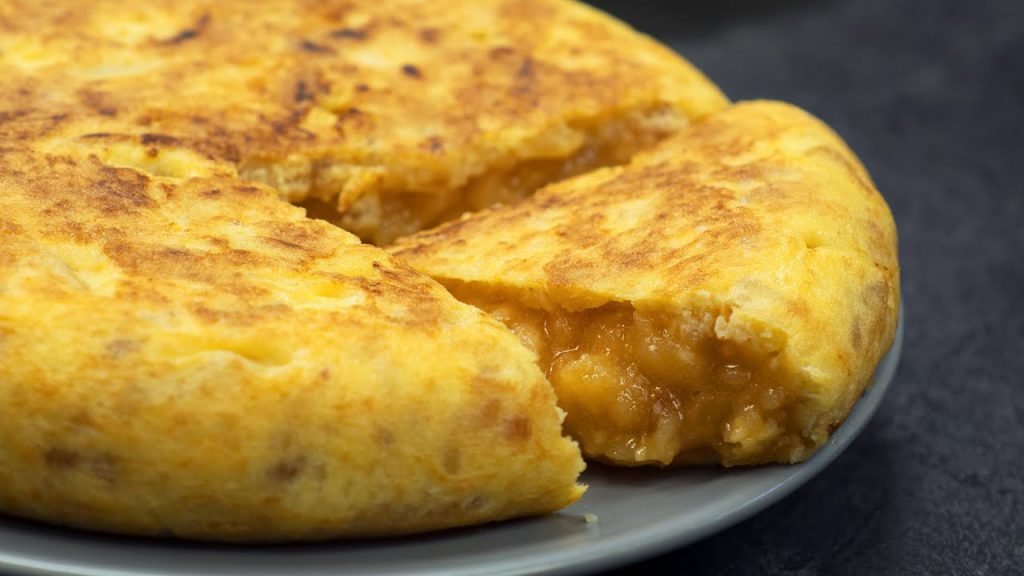
TRADITIONAL SPANISH FOOD

School: Premia de Mar, El Pilar
Melon with ham:

Ingredients:
– Melon ( 1/2 melon = 800g )
– Ham ( 50g )
Proces:
First you have to cut the melon in triangles and take off the melon skin. Then you need to put the pieces in the dish. Later you catch a piece of ham and you cut it into different parts. To finish you put the different pieces of ham on the melon.
It’s ready to eat it!
Salmorejo
Ingredients:
-
1 kg tomatoes
-
1 garlic clove
-
2 eggs
-
Olive oil
-
200 g of chopped bread
-
100 g of iberian ham
-
Water
-
Salt
Elaboration of the “Salmorejo”
1. Boil the eggs with water for 10 minutes, after the water starts boiling: refresh and reserve the eggs.
2. Wash the tomatoes, cut them, and grind them. Then filter the tomatoes to delete the seeds and peels.
3. Chop the bread and add it to the tomatoes, add the crushed clove of garlic, too. After that, add some salt and 100 ml of olive oil. Grind everything until it gets an homogeneous texture.
4. Cool it in the freezer.
5. Peel the boiled eggs and cut them into dices. Also crush the iberic ham into small bites.
6. Serve cold with the toppings (egg and ham) on it.
7. Enjoy this amazing, healthy and refreshing dish! It comes from Córdoba, Andalucía, Spain.
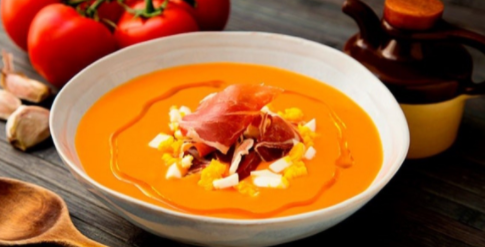
Croquettes:
Ingredients:
250g of Ham
100g flour
200 ml cooked broth
½ Milk
2 teaspoon of extra virgin olive oil (30mL)
1 onion
1 cup of butter (15g)
Bread crumbs
2 eggs
Preparation:
- Step 1: Melt butter in large skillet on medium heat. Add onion; cook until soft. Add 1/4 cup flour and mix with wire whisk. Gradually add evaporated milk. Cook over medium heat, stirring occasionally, until mixture comes just to a boil and is thick and creamy. Add ham, parsley, sherry, black pepper and nutmeg; mix well. Cook for 4 to 5 minutes on low heat. Taste; season with additional salt if desired.
- Step 2: Pour ham mixture into 8-inch-square baking pan. Cool in refrigerator for 30 to 45 minutes so that it will be easy to handle.
- Step 3: Beat eggs with water in a small mixing bowl until frothy. Combine bread crumbs and 3 tablespoons flour and place in a second bowl or plate. Scoop out a heaping teaspoon of ham mixture from chilled pan, or divide mixture in pan by cutting it into thirds crosswise and in eights lengthwise. Shape into logs 1 1/2 inches long and 3/4-inch wide. Dip croquettes into eggs and roll in crumb mixture until evenly coated. Place croquettes on large jelly roll pan or baking sheet; cover with plastic wrap. Refrigerate for 30 minutes.
- Step 4: Heat oil in a deep fryer to 350° F. Fry croquettes for 2 minutes or until golden brown. Drain on paper towels. Place on serving platter. Squeeze lime wedges over croquettes and serve with extra wedges. Serve hot.
Published: Nov 20, 2021
Latest Revision: Mar 8, 2022
Ourboox Unique Identifier: OB-1231726
Copyright © 2021







